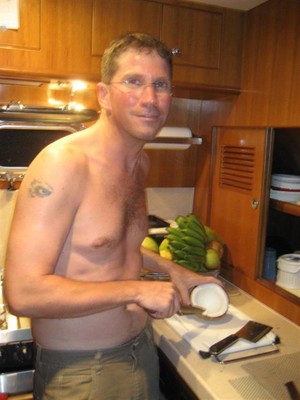We got up early and prepared Kosmos for departure. We were going to Tahaa, another island in the Society Island chain. Fortunately, there wasn’t much to do, so in no time the lines were cast off. Bye Bye Tahiti!

We are noticing a distinct pattern now. The other day when we were on a day trip, the seas were nice and calm. But, of course, since this was an overnight trip, we had strong winds on our port aft quarter (right back corner) producing 6 8 foot following seas (waves coming from behind) with the periodic 10 foot beam wave (from the side) that knocks us all over the place. Why the conditions are so similar every time we are out for more than a few hours is beyond us. It drizzled all day, and as soon as it got dark, rained really hard all night long. Poor Shelley was sick pretty much the entire passage. We all felt bad for her. Eric ended up being the only one that didn’t get sick at all. We turned on the spotlight and got this neat shot of the downpour which followed us almost the whole way.
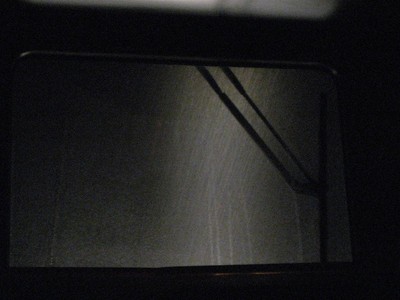
This morning we approached the south entrance to the reef at 0400, in the dark. Not too long ago we would have waited outside the reef until dawn. Eric has become very comfortable with navigating by the charts, navigation aids, radar, and depth sounder. The entrance and channel markers were lit, so he decided to go for entering in the dark. This was our first night entry through a pass. We pulled into the lagoon, then took a 2 hour cruised to the north end of the lagoon threading through a narrow channel with coral on either side. We anchored shortly after sunrise. We were proud of Eric. With the rain clouds blocking stars and moon, he really couldn’t see anything. It was “fly by instruments” the whole way.
Tahaa shares a lagoon with another island, Raiatea. Tahaa is north of Raiatea, and is accessible only by boat. The average tourist must fly to Raiatea then take a ferry to Tahaa. Neither of the islands are big tourist destinations and are supposed to have an “untouched” feel to them. Raiatea was once the cultural and spiritual center of all the Polynesian islands and thus the most important of all before the Europeans made Tahiti the primary island. Tahaa and Raiatea are part of the Society Island chain, along with Tahiti and Moorea.
Both Tahaa and Raiatea have much lower peaks than Tahiti. They look like they are half as tall as Tahiti. There is land mass on the ring of reef around the islands. In the Marquesas and Tahiti there is just the island, and in the Tuomotus it is just the ring around the lagoon, and here you have both. We can see land on both sides of the lagoon when we look out the window. We can see the island of Bora Bora in the distance behind the reef mini-island (called motus).
We anchored in the lagoon closer to the reef motus than the main island of Tahaa. One of the motus has a nice looking hotel on it. We were welcomed by a beautiful rainbow over the reef.
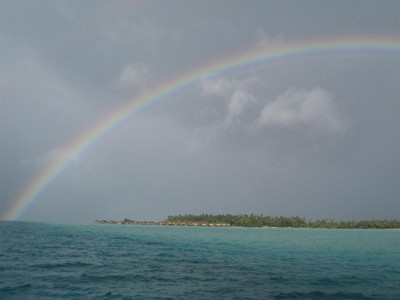
We secured the boat, blew up the inflatable dinghy and headed into the closest town on Tahaa, Tapuamu, planning to go out to breakfast then rent a car to tour the island. It was a cold, wet ride in the rain. We found out there were no cars to rent and no restaurants in walking distance. Here is part of the town from the dinghy.
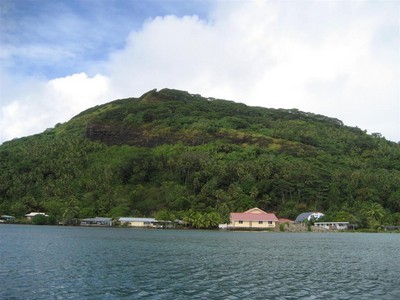
We arranged a tour of the island the next morning, then decided to get breakfast at the hotel near the boat. As soon as we pulled up in our dinghy, a hotel employee came out and asked what we were doing at their swanky private resort. We said we wanted to eat. He looked dubious and escorted us to the front desk, where we were told that we needed to make reservations to eat at least a month in advance, then shooed us off their property. Later we looked up the place in Lonely Planet and found out rooms start at $1,000 American per night. Here is a shot of Kosmos at anchor from the dinghy. You can see one of the reef motus and Bora Bora behind us.

We went back to the boat and made lunch. We decided to go snorkeling. Fortunately, the rain had stopped. We chose this particular location because it is supposed to have excellent snorkeling between the motus next to the hotel. The spot is called Coral Gardens.
As we were getting ready to go, a boat pulled up. It was a local guy selling fruit, wearing a pureu (square cloth the locals wear) wrapped around him like a diaper and no shirt. We had been told in advance to expect him. His name is Norman and he grows all the fruit at his home, then goes boat to boat selling his fruit. Unfortunately, he didn’t speak a word of English, so we couldn’t talk to him beyond our fruit transaction. We got some pamplemousse, papaya, and bananas. Pete really wanted a coconut despite all the warnings of how hard they are to open and eat, so we got one. Norman serenaded us with a song, playing his ukulele and singing. It was great. Norman gave us four extra red bananas, then took off.
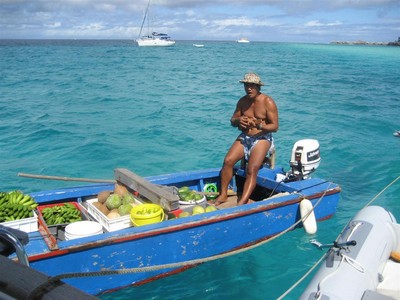

We went on both sides of the motu that appeared to be closest to the hotel. Both areas were extremely shallow, like calf deep in many spots. There were a several times that the dinghy hit coral and we held our breath, praying it didn’t start leaking. The coral wasn’t especially shapely or colorful, there weren’t a lot of fish, and there were a lot of sea urchins everywhere. Big sea urchins in super shallow water can be a little scary.
We got out of the water and headed back to the boat, totally dismayed that the incredible snorkeling wasn’t all that. It seemed nothing was going right for us today!
Back at the boat, Christi made dinner. We thought the red bananas might need to be cooked, so Christi fried up a couple of them to serve with dinner. They were pretty good. They tasted fine uncooked. Pete went to work on the coconut. He tried a variety of knives and techniques to get it open and to get the meat out of the shell. He was working so hard he was sweating. A half hour later, he proudly displayed the “fruit of his labor” fresh coconut ready to eat.
